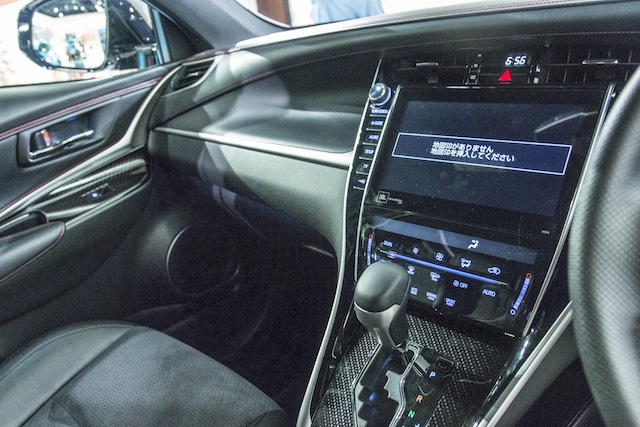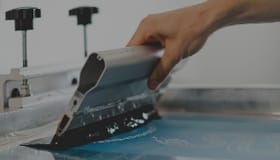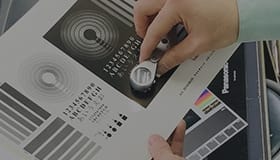Product overview
UV FLX ink series is a UV curable screen printing ink with superior opacity and multi-layer printability compared to conventional UV screen inks, and excellent performance in post-processing molding by vacuum molding, pressure air forming, etc. It can be used for a wide range of applications such as automobile meters, control panels, and home appliance nameplates.
- UV Ink

Application
- Film insert products in general such as automobile interior and home appliance nameplates.
Features, Function
- Excellent opacity
- Excellent multi-layer printability
- Applicable to film insert molding by combining with IMB binder
- Multi color setting
Substrate
- PC more than 0.3m, Easy adhesion treated PET, ABS more than 125μm.
- PC
- Easy adhesion treated PET
- ABS
Dilution
- Dilution not required(If dilution is required, use RE-877 REDUCER within 5 to 10%)
Promoter
- SM-269 DEFOAMER 0 to 1%(if foaming or cissing occurs)
Recommended cleaner
- Screen Cleaner L2
- Applicable to machine cleaning with less hazardous glycol ether types(Glycol ether type cleaning may not be suitable for some types of stencil emulsions, so please be sure to test it beforehand.)
Mesh
- T 300 to 380 mesh(Coverage is 70 to 90m2/kg at 300 mesh)
- In terms of opacity, printing an ink layer thickness of 10-11 µm ± 2 µm with T 300 mesh is recommended.
Drying, Curing
- Accumulated energy: 800 to 1000mJ/cm2、Peak power:800 to 1000mW/cm2 (Eye Graphics UV integral light counter)
- A rough standard: Two 120W/cm Metal halide lamps, lamp height 8 cm, belt speed 8m/min
Standard colors
-
000 MEDIUM
-
001 VICTORIA
-
168 SCARLET
-
174 RED
-
175 RED
-
182 RED
-
234 LIGHT YELLOW
-
263 REDDISH YELLOW
-
277 OPAQUE REDDISH YELLOW
-
391 BLUE
-
581 MAGENTA
-
672 OPAQUE WHITE
-
797 GREEN
-
821 VIOLET
-
911 BLACK
-
972 BLACK
Caution
- Checking adhesion before production: Adhesion may change depending on the substrates, processes, and printing. Be sure to check the adhesiveness before mass production printing.
- Preliminary confirmation of molding conditions: In post-processing molding by vacuum molding, pressure air forming, and insert molding etc., the conditions of design print curing, molding temperature, molding pressure, molding time, mold shape, type of molding resin, etc. affect the molding process. Please conduct sufficient preliminary tests and set each condition appropriately before use.
Safety
- UN No.: Not classified in the definition
- UN Classification: Not classified in the definition
Handling
- Use safety gloves and eyeglasses to protect skin and eyes. If the ink comes in contact with skin, wash with soap and plenty of water (or lukewarm water) and consult with a doctor.
- Containers should be closed tightly after use and stored in a cool and dark place.
- SDS is available upon request. Please request a copy and read it carefully before handling the products.
Resistance
| Test item | Test Conditions | Test results |
|---|---|---|
| Adhesion | JIS K 5600-5-6(cross-cut),1mm interval 6×6、 cellophane tape and peel | 0(no peel) |
| Pencil Hardness | JIS K 5600-5-4 (pencil), Weight 750g, Hardness of the pencil which does not make scar. | 6B |
| Heat | 90℃ 192 hrs. check appearance and peel off | No defect |
| Humidity and cool-heat cycling test | JIS 5600-7-4 10 cycles、100℃(2hrs)~25℃(2hrs)~-40℃(2hrs)~25℃(2hrs)check appearance and peel off | No defect |
| Humidity | JIS K 5600-7-2 (Continuous condensation) 65℃ 95%RH、96 hrs.、check appearance and peel off | No defect |
| Out-gas | Covered with Acrylic plate, 103℃ 48 hrs. check haze of the plate | No defect |
| Alcohol | Gakushin scrub tester, cotton soaked ethyl alcohol, weight 200g, 10 back and forth, check peel off | Slight gloss change |
| Detergent | Cotton soaked “Mama Lemon” soaked, weight 200g, 10 back and forth, check appearance. | No defect |
| Artificial Sweat | Artificial sweat, cotton soaked, weight 200g, 10 back and forth, check appearance. | No defect |
| Scrub | Gakushin scrub tester, cotton, weight 500g, 30 back and forth, check color fade | No defect |
| Bend | JIS K5600-5-1(Cylindrical Mandrel) 3mmø, check cracks | No defect |
| Punching | Punching by press machine | No defect |
| Blocking | Weight 200g/cm2 80℃ | No defect |
| Accelerated Weathering | Weather-meter, BP Temp. 63±3℃, check color fade and peel off | (600hrs.) No defect |
Test Condition
- Test condition 【120W/cm 2 Metal halide lamps, height 8cm, belt speed 8m/min】 【T 300】 【Substrate: PC 0.5t】
- Above resistance test results are measured results in our laboratory and they are not guaranteed values.
- Information contained in this catalog may change without prior notice.
FAQ
-
What is the meaning of FIM/IMD?
-
The abbreviations, FIM and IMD, stand for Film Insert Molding and In-Mold Decoration. For these methods, the printed film is set into the mold and molded with molding resin as the finished product.
We recommend reading the FIM/IMD technology White Paper:
(1) FIM/IMD – 3 Process stages & Benefits
(2) FIM/IMD – Screen printing process –
(3) FIM/IMD – Forming process –
(Final) FIM/IMD – Injection process –We recommend reading the following reports:
Environmentally Friendly FIM/IMD Ink and Binder
IMB-HF006 Binder (Halogen Free, Environmentally Friendly Binder for IMD/FIM)
IPX-HF Screen Ink (2 Pack Halogen Free Environmentally Friendly Ink for IMD/FIM)
2 Pack Ink for FIM/IMD Applications
Adding High Value to Products with FIM/IMD (Part 3)
Adding High Value to Products with FIM/IMD (Part 2)
Adding High Value to Products with FIM/IMD (Part 1)
Teikoku Provides New Color and New Function to Plastic Products
FIM/IMD Technique: FIM Ink Design Technique,Optimization Technique of Forming Conditions -
Using FIM/IMD method, can you give us some examples of substrate film and molding resin combinations?
-
PC, PET, and Acrylic substrate sheets are suitable. Suitable resins are PC, PMMA, PC/ABS, AS, etc. However, PP and Olefin are currently difficult to use because they do not have good adhesiveness to the substrate materials.
-
What is the difference between Film Insert Molding and In Mold Decoration? Do you use different inks for each?
-
For the FIM method, the printed surface will be placed between the substrate sheet and the resin. On the other hand, for IMD method, the printed surface will appear on top of the adhered layer of the substrate sheet and the resin. The type ink will depend on the application and your requirements.
-
What is the largest size that you can use for the Insert Molding Method?
-
Theoretically, it depends on the capability of molding machine. However, there is an elongation limit of the substrate sheet; it varies depending on the printing materials you are using.
-
Can you give some examples of the type of industry where a combination of ink and molding method is being used? What would be the actual finished product?
-
The main industries will be automobile interiors, amusements, and home appliances. Their finished products are such items as speedometers, pinball game machines, water boilers, TVs and possibly as cover material in various other areas.
-
Do you have any restrictions when you use functional inks for molding inks?
-
There are some limitations of color hue, glossiness, and other properties. Sometimes, Teikoku Inks is unable to meet a customer’s requirements due to the design of the product.
-
We found that sometimes when we peel off the print from the injected resin, ink remains on one side or sometimes on both sides. Why does this occur?
-
In the case of ink remaining on the substrate, adhesion to the injected resin is poor. When ink remains on the injected resin, the adhesion to the substrate is poor. This is delamination. When ink remains on both sides, adhesion to substrate and injected resin are good, but the cohesion of the ink layer is poor. This is a cohesion failure.
-
The printed layer peeled away from the injected resin. What should we do?
-
This may be due to a mismatch of ink, substrate and the resin. Please contact our representative.
-
We have always had good adhesion, but suddenly peeling has occurred. What should we do?
-
Ink attached so far but it suddenly peeled off. I don’t know what to do.
Please check the following.
(1) Film thickness of printed ink layer
Thinner binder layer tends to have weaker adhesion.
(2) Drying conditions for printed ink layer
If ink doesn’t dry sufficiently, the strength of the printed ink layer becomes weak and cohesive fracture will occur.
(3) Are there any additives such as defoamer contained in ink or binder?
If additive such as defoamer is added in ink, ink’s adhesion to resin tends to be weak.

